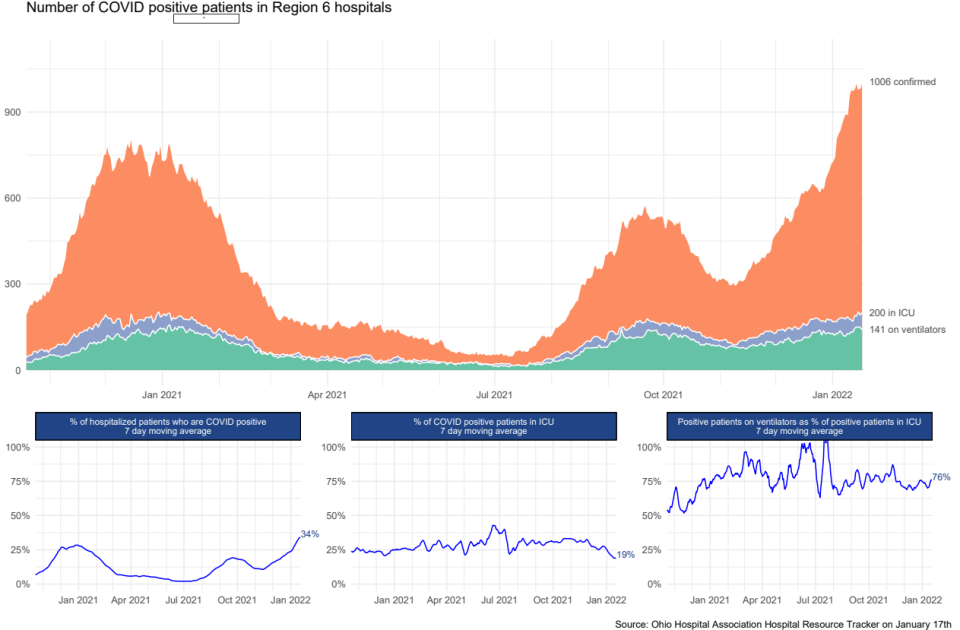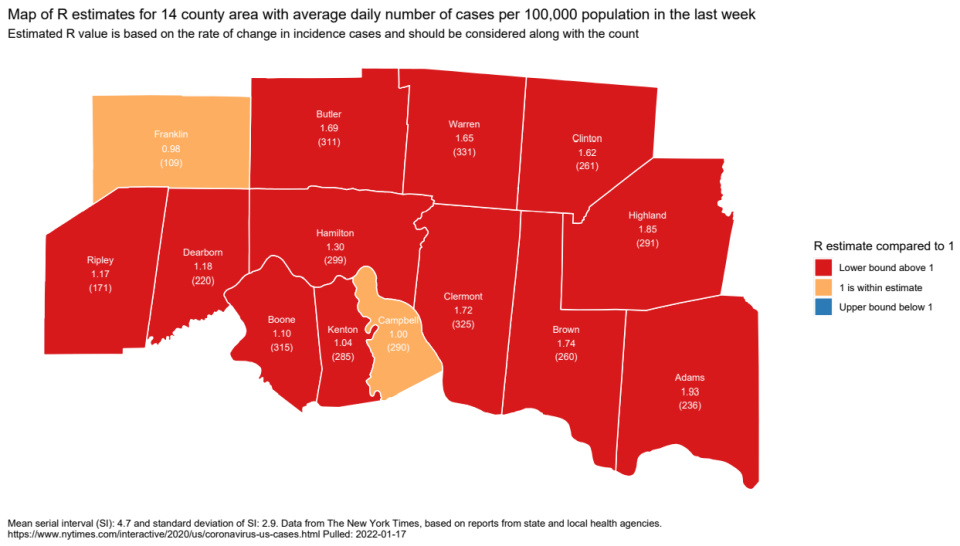COVID-19 surge: 200 patients in ICU as total in Cincinnati area hospitals holds near 1,000
Pressure from cases of COVID-19 continued unabated on the Cincinnati region's 40 hospitals during the holiday weekend. The number of COVID patients in ICU beds hit 200 for only the third time in the past year.
One of every three patients in the hospitals has been sickened by the omicron variant wave of the novel coronavirus. The "all hands on deck" situation is lingering two weeks after three local health systems said they were postponing or limiting some elective surgeries due to the latest COVID-19 surge.
As of Monday, the last date for which data is publicly available, the Cincinnati region's 40 hospitals had the highest number of COVID-19 cases since January 2021 with 1,006 patients (200 in intensive care and 141 on ventilators).

COVID at home: What do I need, doc? Tips on self-care
Omicron and masks: N95, KN 95 or surgical? Local doctors give advice
COVID and schools: Up-to-date list of building and district closures
Of the region's 513 intensive care beds, 99% were full, according to the situational dashboard for the Health Collaborative, the region's trade group for health systems. That means that five ICU beds were available. Meanwhile, 98% of the region's roughly 2,500 medical-surgical beds were full.
The surge in patients in local hospitals is due to a rise in overall cases attributed to the more contagious omicron variant of the novel coronavirus. The number does not differentiate between people admitted for COVID-19 and people admitted for other conditions who tested positive. But patients in the latter group can face additional complications due to the virus and still pose infection risks for staff and patients.
The hospitals used the same tactic in the spring of 2020 in the first wave of the pandemic to keep the health systems from crashing.
TriHealth, Mercy Health and St. Elizabeth were the first to cut back on elective surgeries but then were quickly followed by Premier Health, which operates Atrium Medical Center in Middletown, and Kettering Health System, which operates Kettering Health Hamilton.
The positivity rate for new COVID-19 tests in the Cincinnati region remains at 33.7% or roughly 1 in 3. The rate of new infections rose in southwest Ohio over the weekend, but the number of cases likely was inflated due to an ongoing backlog of tests.
A commentary posted Friday on the Health Collaborative Situation Dashboard noted "we are not yet certain if our region has peaked" in cases from the omicron wave as apparently has happened in northern Ohio.
COVID tests:Tips on using home kits so you don't waste them
The city of Cincinnati reimposed an indoor mask mandate on city facilities and employees on Jan. 12.
The city previously declared a state of emergency on Dec. 29 because of a lack of fire department staffing. Gov. Mike DeWine that same day mobilized another 1,250 members of the Ohio National Guard to help at the state's hospitals, as the more contagious but less dangerous omicron variant of the novel coronavirus takes hold in the state.

What's happening with infections?
The rate at which the novel coronavirus is reproducing locally indicates there is community spread of the virus.
The situational dashboard reports the R naught, a value that measures spread, for the region and individual areas of it for the last seven days. Monday's reading for the region was 1.21, according to the Health Collaborative's Situational Dashboard. In Hamilton County, it was 1.36. Any reading over 1 indicates community spread of the virus.
Omicron: How its symptoms differ from a cold or the flu
What's the local toll since the COVID-19 pandemic started?
A total of 4,679 residents of the 16-county region have been reported as dying of COVID-19, an Enquirer analysis shows. A total of 458,109 cases of the illness have been reported. That number may not reflect the full picture because some people have had the disease more than once – and an untold number of infections aren't in the total because they were discovered by people using in-home tests and were not reported to health officials.
This article originally appeared on Cincinnati Enquirer: COVID-19 surge: Number of patients in Cincinnati hospitals passes 1,000

